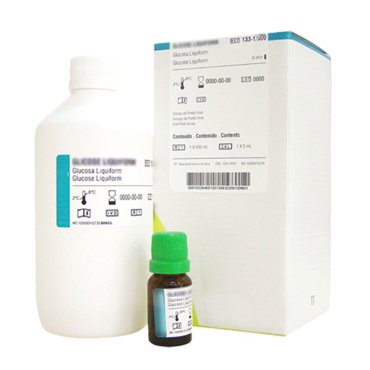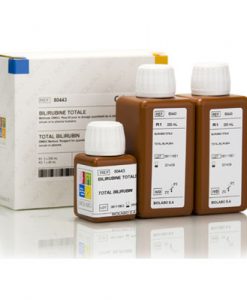Cromatest Cholesterol MR Biochemistry Reagent (Ready to Use) – 100 Test
৳ 1,400৳ 1,600 (-13%)
In stock
Packaging Size: (2×50) ml
Origin: Spain
Brand : Cromatest / Linear
Packaging Type: Bottle
Test/Pack: 100Test
Method: Enzymatic colorimetric method
Cromatest Cholesterol MR Biochemistry Reagent
PRINCIPLE:
This method for the measurement of total cholesterol1,2 in serum involves the use of three enzymes: cholesterol esterase (CE), cholesterol oxidase (CO) and peroxidase (POD). In the presence of the former the mixture of phenol and 4-aminoantipyrine (4-AA) are condensed by hydrogen peroxide to form a quinonimine dye proportional to the concentration of cholesterol in the sample.
REAGENT COMPOSITION:
| R1 | Monoreagent. PIPES 200 mmol/L pH 7.0, sodium cholate
1 mmol/L, cholesterol esterase > 250 U/L, cholesterol oxidase > 250 U/L, peroxidase > 1 KU/L, 4-aminoantipyrine 0.33 mmol/L, phenol 4 mmol/L, non-ionic tensioactives 2 g/L (w/v). Biocides. |
| CAL | Cholesterol standard. Cholesterol 200 mg/dL (5.18 mmol/L). Organic matrix based primary standard. |
STORAGE AND STABILITY: Store at 2-8ºC.
The Reagents are stable until the expiry date stated on the label. Discard the reagent if presents an absorbance over 0.100 at 500 nm against distilled water or if it fails to recover the declared values of control sera.

REAGENT PREPARATION:
The Monoreagent and the Standard are ready-to-use.
SAMPLES:
Serum or EDTA plasma free of hemolysis.
Cholesterol in serum or plasma is stable up to 5 days at 2-8ºC and for a few months at –20ºC.
INTERFERENCES:
Highly icteric samples should be discarded.
Lipemic samples (triglycerides > 10 g/L) require a blank correction. Use the same volume of sample with isotonic saline in the place of the reagent.
Other interfering compounds have been described.3
MATERIALS REQUIRED:
Photometer or colorimeter capable of measuring absorbance at 500 ± 10 nm.
Constant temperature incubator set at 37ºC. Pipettes to measure reagent and samples.
PROCEDURE:
1.Bring reagents and samples to room
2.Pipette into labelled tubes:
|
TUBES |
Blank |
Sample |
Standard |
| Monoreagent Sample Standard | 1.0 mL
– – |
1.0 mL 10 mL
– |
1.0 mL
– 10 mL |
Mix and incubate the tubes 10 minutes at room temperature or 5 minutes at 37ºC.
Read the absorbance (A) of the samples and the standard at 500 nm against the reagent blank.
The color is stable for at least 30 minutes protected from light.
CALCULATIONS:
Samples with concentrations higher than 600 mg/dL should be diluted 1:2 with saline and assayed again. Multiply the results by 2.
If results are to be expressed as SI units apply: mg/dL x 0.0259 = mmol/L
REFERENCE VALUES:
Updated clinical values of total cholesterol used to classify risk groups.
| Total Cholesterol | Risk Classification |
| < 200 mg/dL (< 5.18 mmol/L) | Desirable |
| 200-239 mg/dL (5.18-6.2 mmol/L) | Borderline high |
| > 240 mg/dL (> 6.2 mmol/L) | High |
QUALITY CONTROL:
The use of a standard to calculate results allows to obtain an accuracy independent of the system or instrument used.
To ensure adequate quality control (QC), each run should include a set of controls (normal and abnormal) with assayed values handled as unknowns.
CLINICAL SIGNIFICANCE:
Cholesterol exists in the human blood as a free sterol and in an esterified form. The knowledge of the plasma level of lipids (cholesterol and triglycerides) together with lipoproteins of high and low density (HDL and LDL) aids in the detection of many conditions bound to metabolic disorders of high risk. The imbalance in the level of lipoproteins in plasma leads to hyperlipoproteinemia’s, a group of disorders that affects lipid levels in serum, causing coronary heart disease (CHD) and atherosclerosis, conditions in which the cholesterol levels are important tools in their diagnosis and classification.
Jaundice of the obstructive type usually is accompanied by an elevated total serum cholesterol with a normal ester fraction. Diabetes, hypothyroidism, and certain types of kidney disease are other disorders that may exhibit the same cholesterol disturbance.
Low total cholesterol values with normal ester fractions are noted mainly in hyperthyroidism and malnutrition.
ANALYTICAL PERFORMANCE:
- Linearity: Up to 600 mg/dL
- Precision:
| mg/dL | Within-run | Between-run | ||||
| Mean | 143 | 162 | 267 | 143 | 162 | 267 |
| SD | 2.4 | 2.1 | 1.7 | 2.9 | 3.1 | 4.3 |
| CV% | 1.7 | 1.29 | 0.64 | 2.02 | 1.91 | 1.61 |
| N | 20 | 20 | 20 | 10 | 10 | 10 |
Replicates: 20 for each level.
Replicates: 10 for each level Instrument: CECIL CE 2021 for 8 days.
- Sensitivity. Using a 1:100 sample/reagent at 500 nm, 10 mg of cholesterol will produce a net absorbance of approximately 030.
- Correlation. This assay (y) was compared with a similar commercial method (x). The results were:
N = 40 r = 0.998 y = 1.007x – 1.327
REFERENCES:
Allain, C.C., Poon, L.S., Clau, C.S.G, Richmond, W and Fu, P.D. Clin. Chem. 20 : 470 (1974).
Richmond, W. Ann. Clin. Biochem. 29 : 577 (1992).
Young, D.S. Effects of Drugs on Clinical Laboratory Tests. 4th Edition. AACC Press (1995).
SPECIAL REPORT. Executive Summary of the Third Report of the National Cholesterol Education Program (NCEP) Expert Panel on Detection, Evaluation, and Treatment of High Blood Cholesterol in Adults (Adult Treatment Panel III). JAMA. 285 : 2486 (2001).
Brand
Chromatest
Linear
You must be logged in to post a review.








Reviews
There are no reviews yet.